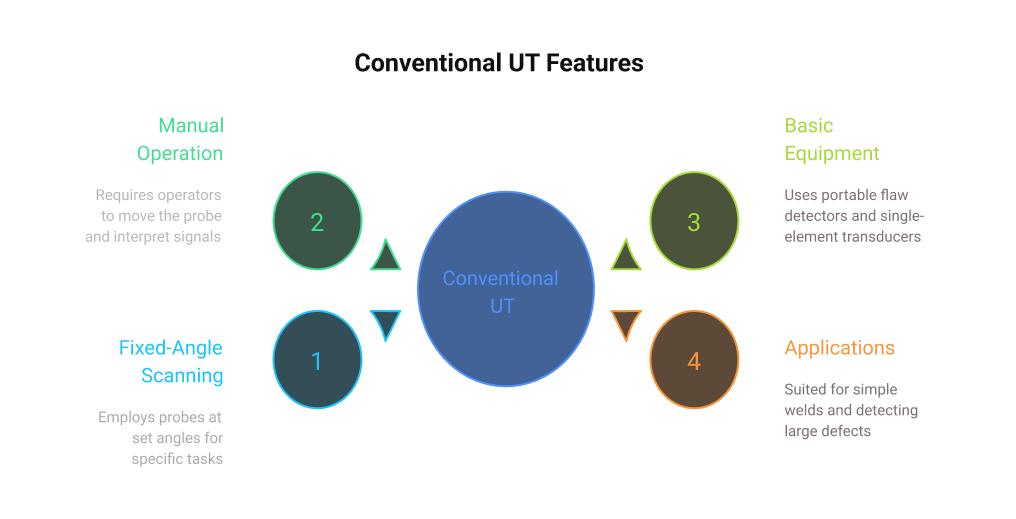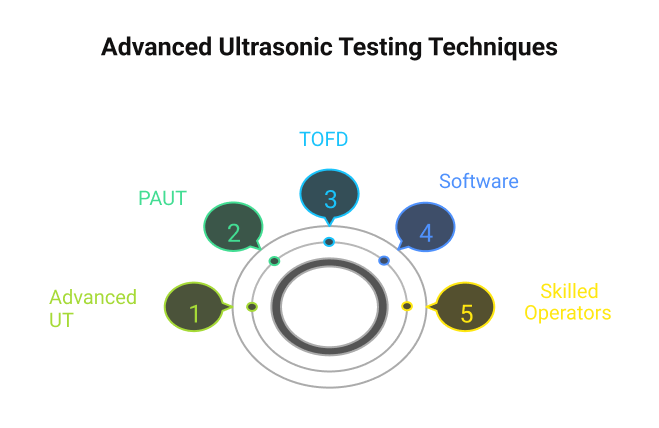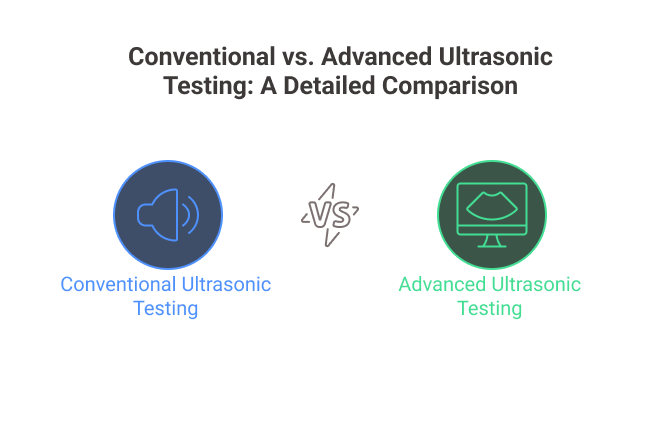Table Of Contents
- Principles of Ultrasonic Testing
- Conventional Ultrasonic Testing: Key Characteristics
- Advanced Ultrasonic Testing: Key Characteristics
- Comparison: Conventional vs. Advanced Ultrasonic Testing
- Conclusion
Ultrasonic testing is a non-destructive testing (NDT) method that is based upon the transmission of high-frequency sound energy to assess the internal structure and integrity of materials. It allows the inspectors to find discontinuities like cracks, porosity, and absence of fusion that assure reliability of components without inflicting any physical damage. With time, the process has progressed to complex computer-based systems that consist of analog systems that can draw detailed imaging and quantitative data analysis.
This development has spawned two major methods, namely Conventional Ultrasonic Testing (UT) and Advanced Ultrasonic Testing (AUT) that incorporates Phased Array Ultrasonic Testing (PAUT) and Time-of-Flight Diffraction (TOFD). Although traditional UT is still an industry benchmark because of simplicity and cost-efficiency, and portability, exotic UT methods have introduced unprecedented accuracy, speed, and visualization of data to the inspection of complex geometries or significant welds. Whether it is the shift of single-element transducers to phased arrays and digital imaging, this is a significant technological advancement in flaw-detection and material-characterization.
This article will allow the reader to discover the core disparities of traditional and progressive ultrasonic testing- operation principles, equipment needs, accuracy, economical and use of this testing in the field. Upon completion, you will gain a profound idea on which is the most suitable technique to use in relation to particular inspection goals, regulatory requirements and project specifications in an industry such as oil and gas, aerospace and power generation industries.
Principles of Ultrasonic Testing
Ultrasonic testing relies on high-frequency sound waves, typically 0.5 to 20 MHz, to detect internal defects in materials like metals, composites, or ceramics. The transducer uses ultrasonic waves that are passed through the material and then bounce off flaws such as cracks or voids. These reflections are channeled in time-of-flight and amplitude to confirm the size, depth, and location of the defect. The procedure involves the calibration of the equipment, couplant (e.g. gel or water) to transmit the sound, and scanning the surface. Simple methods of UT utilize single element transducers (that have fixed angles), whereas more advanced methods of UT, including PAUT and Time-of-Flight Diffraction (TOFD), utilize more elements and provide increased flexibility and accuracy using more advanced signal processing.
Conventional Ultrasonic Testing: Key Characteristics
Conventional UT, commonly referred to as manual UT, involves transmission of sound waves at a fixed angle using a single-element transducer. The pulse-echo technique is common, whereas the transducer transmits and captures waves, with the reflections showing in a wave form A-scan on a flaw detector. The steps include choosing a transducer frequency (e.g. 2-5 MHz on welds), calibrating it on a reference block, and by hand scanning the area under test. It is also a standard used when it comes to weld inspection, thickness measurement, and characterization of a material due to simplicity and set standards such as ASME and API.
Key Features of Conventional UT
- Fixed-Angle Scanning: Employs probes at set angles (e.g., 0°, 45°, 70°) for specific tasks.
- Manual Operation: Requires operators to move the probe and interpret signals in real time.
- Basic Equipment: Uses portable flaw detectors and single-element transducers, keeping costs low.
- Applications: Suited for simple welds, thickness gauging, and detecting large defects in pipelines or pressure vessels.

Advanced Ultrasonic Testing: Key Characteristics
Advanced UT incorporates methods such as PAUT and TOFD using multi-element transducer and digital signal processing to improve the capabilities of an inspection. PAUT is an electronically steerable and focused sound beam employing transducer arrays to scan over several angles with a single pass. TOFD uses two probes to time based on the diffracted wave-of-flight so as to provide accurate defect sizing. These techniques utilize complex software to create 2D or 3D images, enhancing the visualization of defects. Communicated UT processes contain sophisticated calibration (which can be accomplished with computerised scanners) and need highly-skilled operators (e.g., ASNT Level III).
Key Features of Advanced UT
- Multi-Angle Scanning: PAUT covers multiple angles simultaneously, ideal for complex geometries.
- Automated Systems: Uses mechanized scanners for consistent data, reducing human error.
- Advanced Imaging: Generates C-scans or sectorial scans for clear visualization.
- Applications: Excels in complex welds, composites, and critical components in aerospace or nuclear industries.

Comparison: Conventional vs. Advanced Ultrasonic Testing
Accuracy and Sensitivity
Traditional UT has been highly useful in finding small defects, cracks or those bigger than 1mm, in straight forms of weld. It has a single-angle methodology, which constrains accurate defect sizing, especially a small or complex defects. High sensitivity is obtained by advanced UT, in particular PAUT, where sensitivity approaches 0.5 mm. This has a multi-angle scanning that increases defect characterisation of complex welds or odd geometries. The TOFD can offer sub-millimeter sizing capability, which is suitable in important applications such as pressure vessel welds.
Speed and Efficiency
A conventional UT can be effective when it comes to simple inspections that are of a small nature to the extent that they can be done on the minute per weld. Nevertheless, inspection of large or complicated parts is slowed down by manual scanning because probes need to be moved to change angles by the operators. Modern UT, especially PAUT can save half of the inspection time since it scans over several angles simultaneously. Auto scanners also enhance efficiency whereby the state-of-the-art UT is perfect to be used in handling high volumes of inspections, such as girth welds in pipelines.
Complexity and Operator Skill
This element gives space to the complexity of the task and the skill level of its operators. The traditional UT is not complex, and in many respects, little training is necessary (I.e., ASNT Level I or II training) of probe use and signal interpretation. Its direct configuration is adequate to the regular inspections. State of art UT needs higher expertise as it is associated with complicated equipment and software. The equipment used to operate PAUT arrays require a more advanced certification, and this adds to the cost of training, but guarantees success in tough inspections due to improved TOFD signal interpretation.
Equipment and Cost
The equipment required in conventional UT is cheaper and portable with the flaw detectors and single-element transducers being cheaper by a range of $5,000-$15,000. Minimised consumables and low maintenance ensure the low operating costs. New UT technology such as PAUT, TOFD, can cost many thousands of dollars in equipment and software, often more than $50,000. Advanced UT is also more cost-effective than other forms of inspection despite having a higher initial cost helping to save money in high-stakes projects due to shorter time spent on inspection and avoiding rework.
Safety
Conventional and advanced UT are not dangerous since they utilize sound waves but not radiation. This avoids protective areas or cover as compared to radiographic tests where both are safe to the operators or those facilities that are operational. The occurrence of safety profiles is the same in the two approaches.
Data Output and Storage
Technical UT generates A-scan images, which give rudimentary defect data valued over limited interpretation. It has digital printouts that can be stored but not easily visualized by ordinary people. Advanced UT produces comprehensive 2D or 3D images e.g. sectorial or C-scan, that are more readily interpretable and distributable. These digital records aid in the predictive maintenance and adherence to such standards as API 1104.
Applications and Limitations
Traditional UT is good in basic welds, measurements of thickness, and uniform materials such as steel. Signal scattering is an issue; it has problems with complicated geometries or sound-attenuating materials, including austenitic stainless steel. In this, advanced UT will be best with PAUT serving complicated welds and TOFD serving as a precise sizing of the important parts. Nevertheless, the sophistication and the price of advanced UT render it redundant in simple inspection, whereby conventional UT would do the job.
Real-World Use Cases and Cost Benefits
Standard UT works well in daily duties. A pipeline operator employed the use of conventional UT to measure the thickness of their walls and in the process of doing so, identified corrosion at an early stage and saved a huge sum of $150,000 in potential repair expenses. It was installed in a fraction of minutes and made things mobile, which saved 20% inspection time. Conversely, a nuclear facility had difficulty with conventional UT of complex reactor welds and was not sensitive enough to detect small defects because conventional UT has been limited to a single angle. They have reduced the time of inspection by 40 percent, and eliminated rework, saving them $300,000 due to multi-angle scanning capability and high-resolution imaging of PAUT. These examples demonstrate the usefulness of conventional UT in its application in simple inspection and how the high-level UT is better in complex inspection.
Strategies for Effective Ultrasonic Testing
To maximize conventional UT, apply and use standard measures and processes through calibrated equipment to achieve uniformity in their results. To embrace advanced UT, acquire skills in either PAUT or TOFD, and also utilize automated scanners to reduce errors. Such an approach, uniting the two techniques quality conventional UT to test common items and advanced UT to test parts of high reliability, is cost-effective and performance-based. Both methods can be improved using the signal analysis provided by an AI that can help catch more defects and assist in predictive maintenance.
Selecting the Appropriate Method
The difficulty that NDT professionals, learners, and scholars should have in mind when determining between typical and superior UT should be project needs. Simple welds or thickness gauging can be achieved on conventional UT, and it is cost-effective. Sophisticated UT is more suitable when complex geometry, parts that are vital or when speed and accuracy are important in the inspection of large items. An evaluation of material type, geometry, and regulatory requirements will guarantee a correct decision. This decision can be steered by a professional NDT audit that is most accurate, cost, and highly efficient.
Conclusion
Conventional and advanced ultrasonic testing are essential NDT tools with distinct strengths. Traditional UT is simple and relatively inexpensive to allow frequent checks and advanced UT such as PAUT and TOFD are more precise and fast to suit complex requirements. Both are similar in terms of safety and digital capabilities and should be attended to very carefully, but differences between them in terms of cost, complexity, and application are significant. As you are aware of these factors, you will be able to choose the appropriate method that would guarantee safety, compliance, and save costs on your inspections.
Sources:
- https://www.ndt.net/forum/thread.php?rootID=87140
- https://svkelectronics.com/conventional-vs-advanced-ultrasonic-testing-a-detailed-comparison/conventional-vs-advanced-ultrasonic-testing-a-detailed-comparison/
- https://www.dekra.in/en/advanced-ultrasonic-testing/
- https://www.pmtndt.com/ndt-methods/
- https://www.sciencedirect.com/science/article/pii/S0079642523000877









